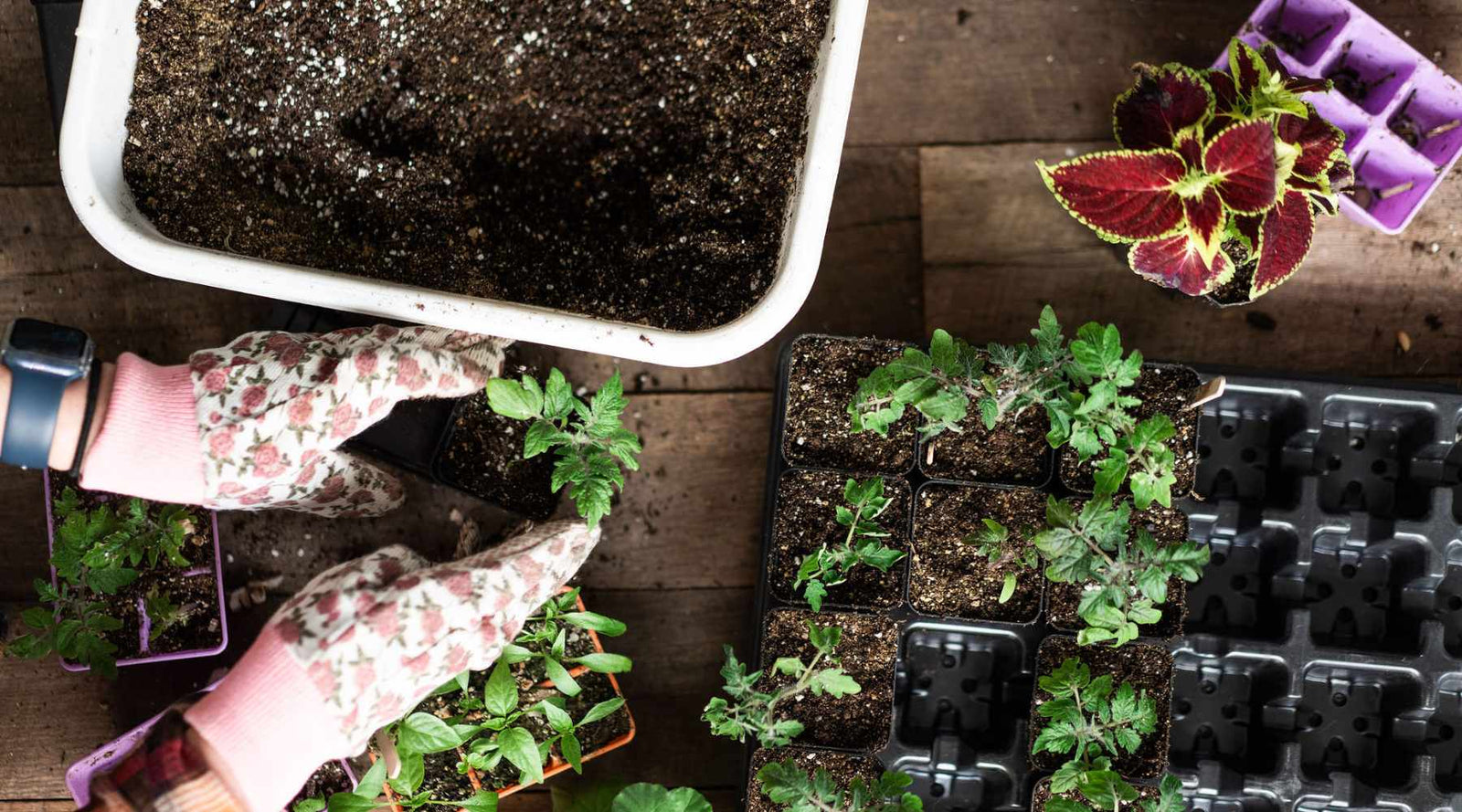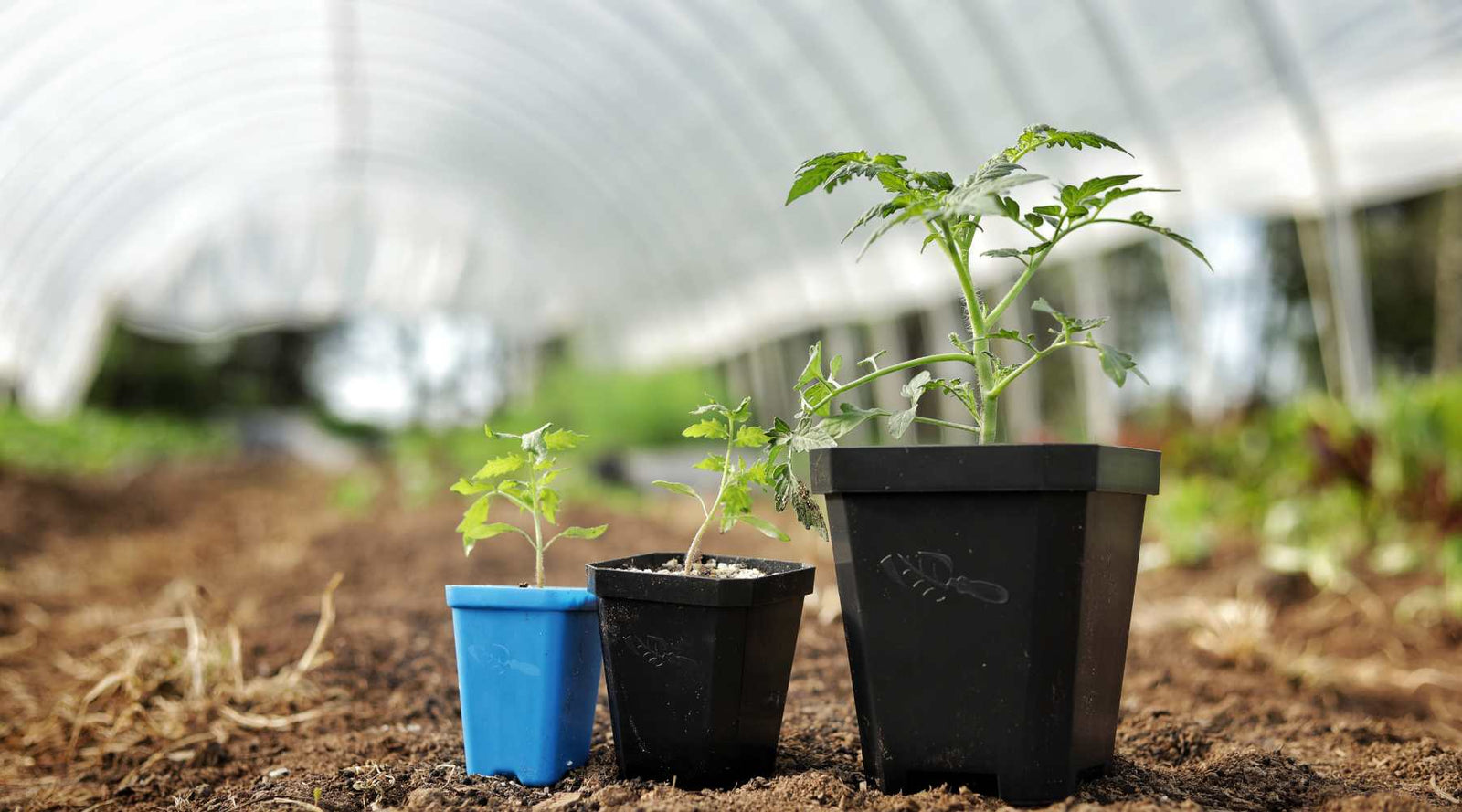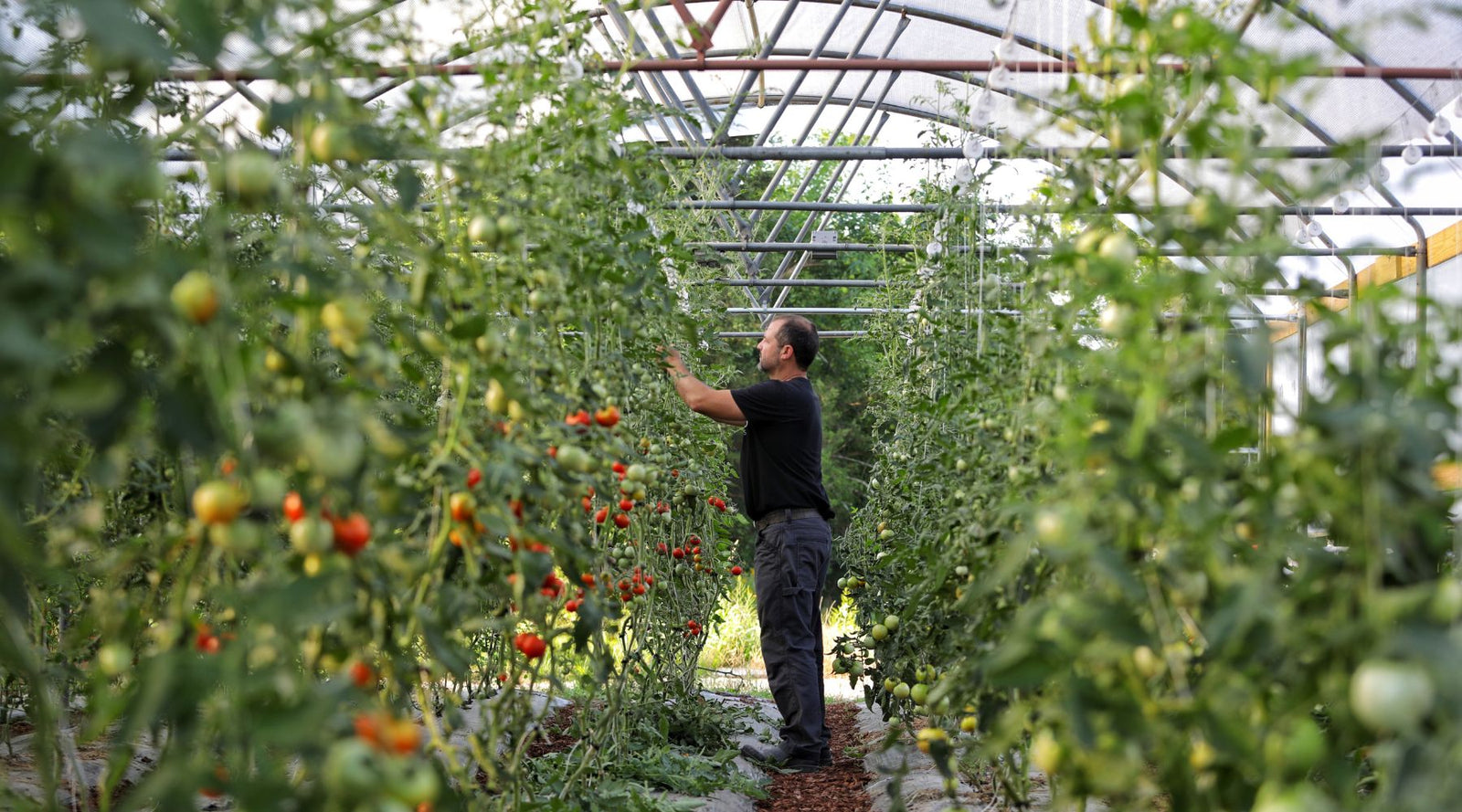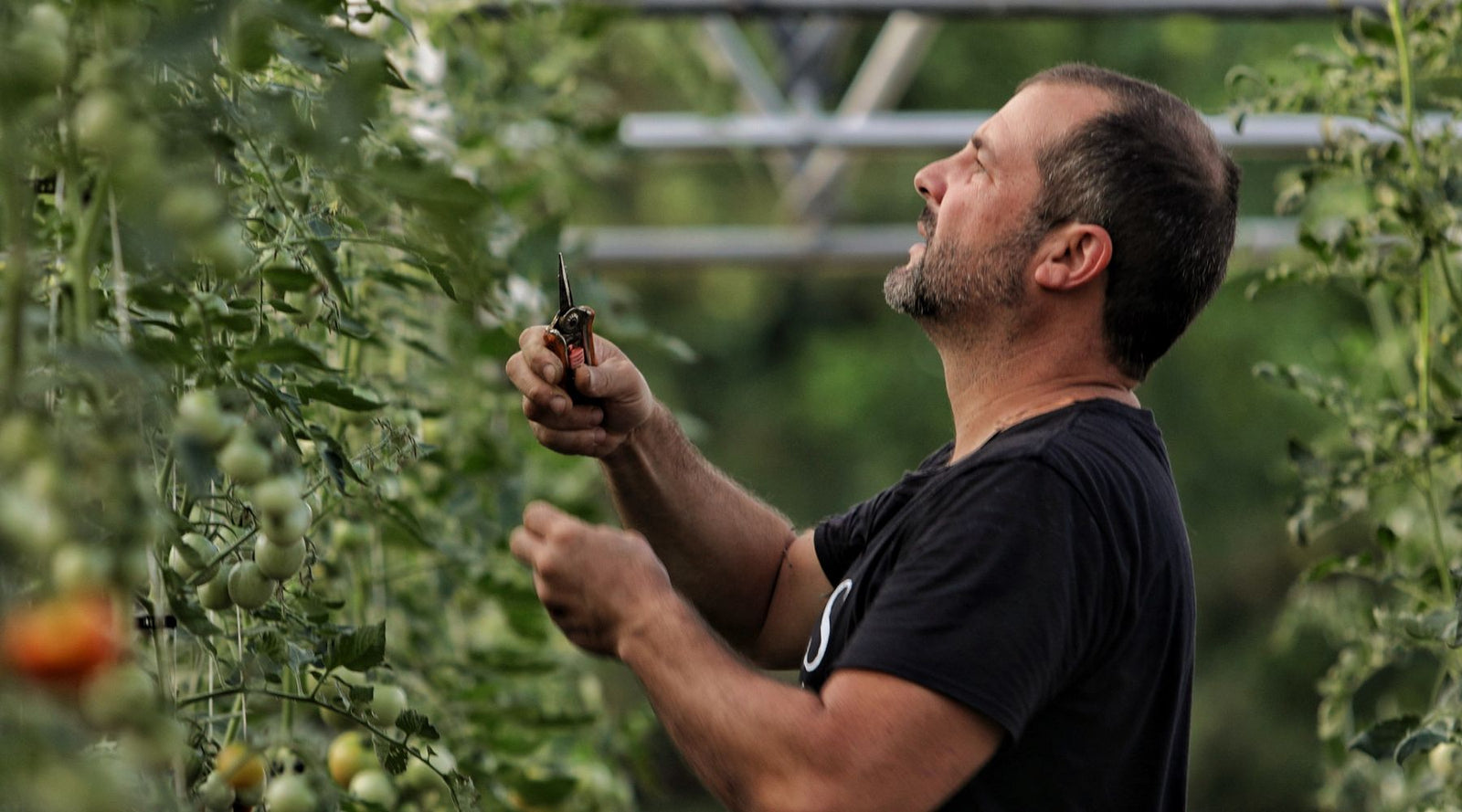Free Shipping on Orders over $75 to the Contiguous US
Free Shipping on Orders over $75 to the Contiguous US
The Ultimate Indoor Tomato Seed Starting Guide for Gardeners
June 10, 2025 12 min read 0 Comments

Tomatoes are one of the most popular crops to grow in the home garden, but high-quality seedlings can set you back quite a bit financially. Why not start your tomato seedlings at home instead? We’ll help you gain the confidence you need to explore seed catalogs, knowing you can start and grow tomato seedlings at home with great success.
When you start plants from seeds, you’ll have access to a broader range of varieties, experience earlier harvests, and grow healthier plants while keeping costs down. Plus, starting seeds indoors is fun and rewarding!

What You’ll Need to Start Tomato Seeds Indoors
Once you have a high-quality seed-starting area, you’ll be unstoppable. Here, we’ll discuss the containers and trays, seed-starting mix, and lighting options we recommend for beginners and experienced master gardeners.
Containers and Trays
Which trays you use for indoor seed-starting is a personal preference, but growers should consider air-pruning cell trays, or small pots for tomatoes as well as 1020s for bottom watering.
| Setup Size | Recommended Trays | Up-Potting Options |
|---|---|---|
| Backyard Gardens | 6-cell trays (fill one 1020 tray at a time with heating mat) | 6-cell Cowpots® (100% biodegradable) |
| Tomato Lovers with Lots of Space | Air-pruning 72-cell trays, 128-cell plug trays, or 1020 mesh deep trays | 3.3" pots or 5" pots as plants grow |
Whatever pots, containers, or trays you select, ensure you sanitize them, that they’re the proper size, and that they have plenty of drainage holes.

Seed-Starting Mix
Not all seed-starting mixes are of equal quality. Light, nutritious, and well-draining soil is crucial for starting tomatoes indoors. Regular garden soil is much heavier than bagged mix made for seed-starting, and there’s a good chance there are dangerous pathogens from past gardening seasons.
We recommend investing in bags of professional-grade, highly-regulated seed-starting mix. Reputable brands regularly test their soils and composts for bacteria, microbial activity, and nutrition and can guarantee no diseases or jumping worms before packaging them for sale.
If garden soil is your only option, add vermiculite and worm castings to improve the drainage and texture.
Sifting your seed starting mix is a valuable step as well, particularly if you are using something like potting soil mixed with coco coir. It helps to blend the mix evenly and removes any large pieces of debris that could cause problems for your tomatoes' root structure.

Selecting Tomato Seeds
Prices vary significantly among seed companies, and there’s a reason. Rigorous testing and years of experience increase the value and cost.
For peace of mind and confidence in seed quality, look for reputable companies that offer reliable hybrids, organic, conventional, and heirloom varieties. These companies should provide clear seed sourcing information, germination rates, and growing recommendations.
Popular home gardener tomatoes include Roma, paste, slicers, beefsteak, various heirlooms, grape, and cherry tomatoes. Try grafting tomatoes using rootstock for increased yields, disease resistance, and vigor.
Order smaller packets with 10 to 30 seeds to experiment with new and unique varieties. Store the seeds properly in a cool, dry area to ensure their viability for future seasons.

Lighting Setup
Providing proper lighting is one of the most critical steps in growing healthy tomato seedlings. Without it, they can’t correctly convert energy from photosynthesizing into growing strong roots and leaves.
There is no way around it; you cannot skimp on lighting and expect healthy plants. A sunny window will suffice for greens, but tomatoes need artificial lighting if you do not have a heated outdoor area with access to sunlight. Most growers use fluorescent or LED lights, each with pros and cons. Here are some key differences between the two types.
|
Fluorescent lighting |
LED lighting |
|
Not best for plants requiring high amounts of light, like tomatoes |
Leads to increased yields and plant health and quality |
|
Leads to a more significant carbon footprint |
Much more energy-efficient, consuming much less energy |
|
Do not provide entire full light spectrum |
Provides a wide range of cool and warm colors, better for all stages of tomato plant growth |
|
Inexpensive |
They are more of an investment, but they last longer |
|
Cannot penetrate the canopy and reach the understory |
Penetrates the canopy to the understory |
If you only have access to fluorescent lights, keep them no more than 12 inches from your plants, or their intensity will not be enough. Keep LED lights anywhere from 12 to 30 inches above the plants. Adjust the height as plants grow so all plants receive ample light and the leaves don’t burn.
Young seedlings will produce more foliage the more light they receive. Most tomato varieties are day-neutral, meaning daylight length doesn’t significantly affect their health and production. However, they need about 12 to 16 hours of artificial light daily, so be prepared to provide this indoors. Setting your grow rack to a timer will ensure they get what they need.
You’ll see T-5 and T-8 options when shopping around for LED bulbs. While you can use either one in your setup, there are key differences:
|
T-5 |
T-8 |
|
More energy-efficient |
Brighter |
|
Diameter of ⅝ inch |
Diameter of one inch |
|
Suitable for small grow setups |
More suitable for large grow setups and commercial growers |
|
Gentle on young seedlings |
More cost-effective for large growers |
|
Offers a wider range of color temperatures for tomato growth |
Recommended for low to medium-light plants |
Watering Tools
Bottom-water the trays in the early stages to prevent seed displacement and fungal growth. Fill a 1020 tray with ½-1 inches of water and place your seed tray inside. Allow it to sit and absorb water for five minutes, then discard any remaining water. Repeat this process until the plants grow for several weeks.
Once the young seedlings look like small, mature plants, gently mist them occasionally with a pressure spray bottle. Keep a fan blowing gently in the tomato growing area to prevent water from staying too long on foliage. Transition to drip irrigation and mulch around the seedlings after transplanting them to deep soil, and avoid foliar disease caused by wet foliage.

Step-by-Step Guide to Start Tomato Seeds Indoors
We’ve broken indoor tomato seed-starting tomato down into seven simple steps. Let’s get started.
1. Choose the Right Time to Start
If a seed packet recommends you sow seeds six to eight weeks before your region’s last frost date, select the date and add it to your sowing schedule. If weather experts predict a long, cold spring, adjust your date to give yourself ample time to prepare your garden before transplant.
Growers get excited in late winter and early spring in anticipation of summer gardens, but starting seeds even a few weeks early can cause long-term damage. Transplants may become leggy and weak if they don’t receive enough sunlight and may begin to produce flowers if they become stressed in their pots. Read When to Start Seeds Indoors on Your Homestead for tips on when to start seeds in your growing zone.

2. Prepare Your Seed-Starting Setup
Organize your sterilized containers and trays by using space under the workstation or shelves. Stack similar items to save space. Arrange small pots or cell trays on your workstation and moisten the soil before starting.
Moisten soil with water one cup at a time until your seed starting mix holds together in a ball without crumbling when squeezed. Break up any large clumps.
Now, you’re ready to add soil to your containers. Gently fill them until the soil is almost to the top. Gently tap the container on the surface to tamp down the soil, or use a second tray of the same size to press flat. Add more soil if needed.

3. Sow the Seeds
Create a slight indentation with your finger, dibber, or pencil, or place one un-soaked seed per cell and press it into the soil about ¼ inch deep. Add more than one seed per cell if they are over three years old to ensure germination of at least one seed.
Cover the cells with loose soil and tamp it down once again. Bottom water the tray, then place it on your heat mat set to the ideal temperature for tomatoes, 70° to 80°F (21° to 26°C). Optionally cover your tray with a humidity dome to hold in humidity. Lower the temperature by about 10°, to 60° to 70°F (15° to 26°C) once germination has occurred.
Read our article, How to Use Humidity Domes When Starting Seeds, for a more in-depth guide to using humidity domes when starting seeds.
If you’re sowing seeds in a 1020 tray space them about ½ inch apart so they don’t shade each other out. Remember, you’ll need to transplant these into larger containers once true leaves emerge. Clearly label every cell or pot with the date sown and variety with tape, wax pencils, or wooden stakes to avoid confusion.
Bootstrap tip: Snap a photo showing all the labels you can refer to if one is lost. Trust us.

4. Provide Proper Lighting
Tomatoes require 12 to 16 hours of artificial indoor lighting daily to mimic the sun they would receive in nature. Plants use a lot of energy, converting that sunlight into energy via photosynthesis to grow delicious, juicy, healthy fruits.
Without sufficient lighting, they won’t reach maturity properly, which leads to stunted growth, decreased flower and fruit production, and a reduced resistance to stress, disease, and pests.
With the proper setup, adjusting lights is easy. Start with the lights close to the newly emerging seedlings and raise them as they grow. Optimizing the distance between growing plants and the light ensures they receive light the appropriate amount of light, without needing to stretch and no burned leaves.
5. Watering and Humidity Control
As discussed, tomato seedlings need the Goldilocks of water amounts --- not too much nor too little. It’s easy to over-water, so monitor the trays often, especially if you’re new to starting tomato seedlings.
Moisture levels are just right if you touch the surface and soil sticks to your finger. If you can see water when you feel the soil, it’s too wet. Your goal is to water just before the soil dries out so it’s consistently moist. Bottom watering is best because the soil will only absorb what it needs. After a few minutes, discard any remaining water in the bottom tray.
Humidity domes placed atop a cell tray create a mini greenhouse effect inside and help the seeds germinate uniformly by keeping temperatures consistent. After germination, remove the lids or open the vents immediately for improved airflow and reduced risk of mildew.
6. Monitor Temperature and Airflow
Providing the ideal temperature of 70° to 80°F (21° to 26°C) and even soil moisture will result in the highest germination rate for tomatoes. The quicker germination occurs, the more energy remains to nourish the young seedlings and convert light into new energy.
Note that temperatures below 50°F (10°C) and above 95°F (35°C) will likely not result in germination or a healthy seeding.
Run a fan on a low, oscillating setting near your seedlings to increase air circulation and prevent the soil surface from developing a crust, mildew, or mold. The movement can help decrease fruit flies and gnats attracted to the damp soil, while encouraging the stems to bulk up in preparation for the wind and rain they’ll experience outside one day.

7. Germination Timeline
Most varieties germinate in five to ten days, although some may take up to two weeks. Consistent heat and water help with timely germination, and the seed’s viability directly affects the odds of it germinating.
Proper seeding depth will ensure healthy, viable seeds emerge quickly, saving energy for cotyledons' emergence and the development of true leaves.
Be patient, but monitor progress daily and ensure you place seedlings under lights immediately after emergence.

Common Mistakes to Avoid When Starting Tomato Seeds Indoors
With practice, starting tomatoes indoors will become second nature. To ensure success, avoid these common mistakes.
Starting Seeds Too Early
Pay attention to the recommended start times on seed packets, such as “six to eight weeks before the last frost date,” and consider your garden’s availability.
For instance, if you know you won’t be able to prepare your tomato area for ten weeks, delay the sowing to ensure they don’t become stressed, leggy, or run out of nutrients before transplant.
Under-watering
Dry soil, wilting leaves, and stunted growth are signs of underwatering. Access to water is vital in the early stages, so monitor your seedlings closely, beginning after emergence. Add a ½ inch of water to a shallow microgreen tray with no holes.
Place your cell tray inside and allow it to absorb water for five minutes. Discard any remaining water to avoid soggy soil and bugs. Water this way once daily or every other day.
Over-watering
It’s tempting to provide your seedlings with lots of water, but over-watering will cause the roots to drown, unable to uptake nutrients and water, and cause root rot.
While you can often save under-watered seedlings, over-watering effects are frequently catastrophic. Read Bottom-watering Seedlings and Microgreens to learn why bottom-watering is the best way to water young seedlings.
Using Improper Soil
Avoid using heavy garden soil. Instead, opt for a light, fluffy seed-starting mix. The light mix allows seeds to emerge without using all their energy, roots to form correctly, and the soil to drain well.
Not Providing Enough Light
Lack of light results in weak and leggy seedlings. Transplanting weak seedlings will not produce vigorous, mature plants. So, ensuring your seedlings get plenty of light in the early development stages will ensure plants remain strong and healthy for the whole season.
Not Clearly Labeling Plants
Label every container with the date sown and variety type to avoid confusion when tomatoes grow and get ready for transplant. Use a wooden stick, plastic label, painter's tape, or a wax pencil.

Tips for Healthy Tomato Seedlings: Up-Potting and Hardening Off
Depending on the size container you sow seeds in, you may need to up-pot two to three times before transplanting the seedlings into their final garden place.
Up-potting ensures root systems have plenty of room to grow and develop and sufficient nutrients to withstand pot life until transplant.
Transplant newly germinated seedlings into a larger container when they have grown two to three sets of “true leaves.” True leaves emerge after the smooth cotyledons emerge. They are scalloped and resemble mature tomato leaves.
Select a container that’s deeper and wider than the one they're currently in when up-potting to give the root system space to expand. You can bury the seedling up to the base of the leaves. The plant will send out new roots from the stem. This will create more robust root systems and can help correct leggy seedlings.
Once seedlings have settled into their new, larger containers, we recommend feeding them with a light, balanced liquid fertilizer to ensure they have ample nutrients.
“Hardening off” is a crucial step in the indoor seed-starting process that you should not skip. It involves introducing seedlings to the outdoor environment to acclimate to direct sunlight, rain, wind, and fluctuating temperatures.
Start this process a week before transplant on an overcast day so plants aren’t sunburned. Place seedlings in a semi-protected area or cover them with a shade cloth.
Gradually leave them outdoors for a longer period until they stay outside overnight. Begin to limit the water they receive. Monitor for signs of stress and bring them back indoors if you see any.
Completing the hardening-off process slowly and gently ensures the plants won’t experience transplant shock, which results in healthier, more resilient mature plants.

FAQs about Starting Tomato Seeds Indoors
What is the best time to start tomato seeds indoors?
Seed packets recommend starting tomatoes six to eight weeks before the last frost date. The exact time will depend on your garden (outdoor garden space versus protected in a low tunnel or greenhouse), region, weather forecast, and access to frost protection.
Can I use regular potting soil to start tomato seeds?
Select a lighter soil designed for seed-starting that provides much better drainage. If you can only access regular potting soil, incorporate vermiculite or coco coir to improve the texture.
Do I need grow lights, or will a sunny window work?
We recommend that home growers set up an area with grow lights. Tomatoes require regular access to high-quality light, so while a south-facing window may suffice when growing greens, tomatoes require ample lighting to develop and grow strong stems and root systems.
How long does it take for tomato seeds to germinate?
Seed germination should occur in five to ten days, but it may occur much earlier with the assistance of heat mats and bottom watering. The exact time depends on your setup, soil temperature, seed viability, and variety.
What temperature is best for growing tomato seedlings?
Use a heat mat to provide seeds with their preferred germination temperature, which is between 70° and 80°F (21° and 26°C). Once germination has occurred, lower the temperature by about 10°, but keep them cozy around 60° to 70°F (15° to 26°C).
Remember, tomatoes originated in South America and were domesticated as far north as Mexico before 500BC, so for the best results, you should provide them with an environment as close as possible to what they would receive in nature in their native area.

What should I do if my seedlings become leggy?
Tomatoes are adventitious rooters, meaning their stems will sprout new roots, called aerial roots, under the soil surface, no matter how deeply you plant them.
To salvage leggy tomato seedlings, up-pot them into a deeper container and cover the stem with fresh soil to the leaf level.
Bottom watering will encourage the roots to stretch, creating a more robust root system. Above-ground growth will bulk up, and the plant will grow new leaves.
You can also prune the top section of tomato plants if they have at least three sets of leaves. Read Pruning Indeterminate Tomatoes for Maximum Production in a Hoop House if you are unfamiliar with pruning tomatoes.
Can I reuse containers from last year?
Sanitize containers before reusing them to ensure no lingering fungus or bacteria affects this year’s crops. Our article, How to Wash and Care for Seedling Trays, provides detailed information on properly doing so.
When is it safe to transplant tomato seedlings outdoors?
Wait until the risk of frost has passed in your growing region. To avoid transplant shock, air temperatures should be consistently above 50°F (10°C), and the soil should be at least 60°(15°C). Be prepared to cover new transplants with frost blankets when overnight temperatures dip.
Also in Growing Tomatoes

Growing Tomatoes for the Urban Farm
March 17, 2025 6 min read 0 Comments

Managing Overgrown Tomatoes
April 03, 2024 10 min read 0 Comments

Pruning Indeterminate Tomatoes for Maximum Production in a Hoop House
April 03, 2024 5 min read 0 Comments
Recent Articles
- Growing Tomatoes for the Urban Farm
- Managing Overgrown Tomatoes
- Pruning Indeterminate Tomatoes for Maximum Production in a Hoop House
- Using the Lower and Lean Method for Indeterminate Tomatoes in a Hoop House
- Building Trellis for Indeterminate Tomatoes
- The Ultimate Indoor Tomato Seed Starting Guide for Gardeners
Subscribe
Sign up to get the latest on sales, new releases and more …
